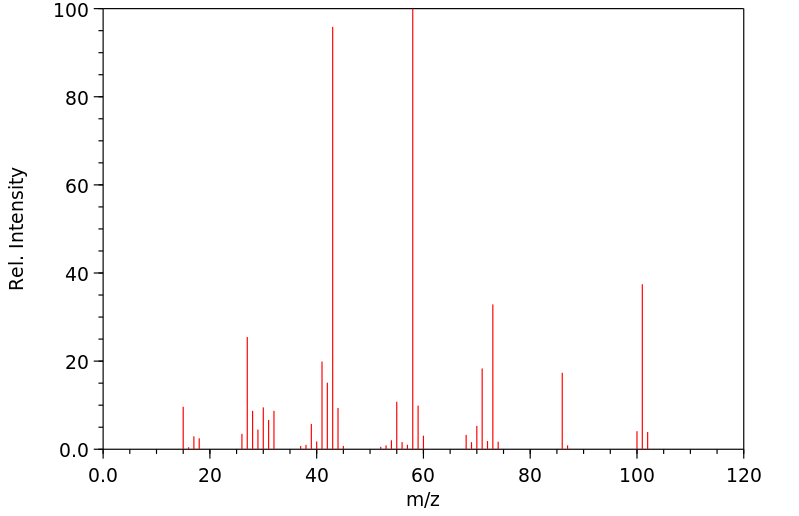N,2-二甲基丙酰胺 | 2675-88-9
中文名称
N,2-二甲基丙酰胺
中文别名
N-甲基-2,2-二甲基乙酰胺
英文名称
N-methylisobutyramide
英文别名
N-methyl-2-methylpropionamide;N,2-Dimethylpropanamide
CAS
2675-88-9
化学式
C5H11NO
mdl
——
分子量
101.148
InChiKey
IXHFNEAFAWRVCF-UHFFFAOYSA-N
BEILSTEIN
——
EINECS
——
-
物化性质
-
计算性质
-
ADMET
-
安全信息
-
SDS
-
制备方法与用途
-
上下游信息
-
文献信息
-
表征谱图
-
同类化合物
-
相关功能分类
-
相关结构分类
物化性质
-
熔点:20 °C
-
沸点:110 °C(Press: 17 Torr)
-
密度:0.9089 g/cm3(Temp: 16 °C)
-
保留指数:940
-
稳定性/保质期:
存在于烟叶中。
计算性质
-
辛醇/水分配系数(LogP):0.6
-
重原子数:7
-
可旋转键数:1
-
环数:0.0
-
sp3杂化的碳原子比例:0.8
-
拓扑面积:29.1
-
氢给体数:1
-
氢受体数:1
安全信息
-
海关编码:2924199090
SDS
上下游信息
-
下游产品
中文名称 英文名称 CAS号 化学式 分子量 —— N-formylisobutyramide 3679-12-7 C5H9NO2 115.132
反应信息
-
作为反应物:描述:参考文献:名称:[EN] COMPOUNDS DERIVED FROM MUSCODOR FUNGI
[FR] COMPOSÉS DÉRIVÉS DE MUSCODOR FUNGI摘要:公开号:WO2010132509A3 -
作为产物:参考文献:名称:呋喃支架文库形成的易位环加成-环还原方法。摘要:描述了用于选择性形成基于呋喃的模板指导的支架的一般环加成-环还原复分解程序。另外,还讨论了与文库构建有关的特征,例如偶极形成的化学选择性。通过对温度敏感裂解步骤的研究,发现呋喃的合成在生理温度下被水性介质加速,从而在生物学相关条件下从固相得到纯产物。铑(II)介导的环加成反应的化学选择性使得在存在许多碳烯活性官能团的情况下选择性地形成关键的偶极中间体,从而有助于小化合物库的拆分池组合合成。DOI:10.1016/s0968-0896(98)00115-1
文献信息
-
Influences of Ligand Backbone Substituents on Phosphinecarbonylpalladium and -nickel Catalysts for Ethylene Polymerization and Copolymerization with Polar Monomers作者:Ningning Zhu、Tao Liang、Yongshuang Huang、Wenmin Pang、Min Chen、Chen TanDOI:10.1021/acs.inorgchem.1c01490日期:2021.9.6used in ethylene polymerization and copolymerization with polar monomers. The Pd and Ni catalysts can achieve high activities as well as high polymer molecular weights in both ethylene polymerization and copolymerization with polar monomers. The electron-donating group from the carbonyl side can effectively increase the polymer molecular weights. Utilization of a cyclic backbone structure can increase
-
Alpha- haloenamine reagents申请人:Pharmacia Corporation公开号:US20030080320A1公开(公告)日:2003-05-01The present invention describes immobilized haloenamine reagents, immobilized tertiary amides, methods for their preparation, and methods of use.本发明描述了固定化的卤胺试剂、固定化的三级酰胺、其制备方法以及使用方法。
-
Aromatic and heteroaromatic acid halides for synthesizing polyamides申请人:Pharmacia Corporation公开号:US20030105279A1公开(公告)日:2003-06-05The present invention is directed to protected amino acid halide monomers and oligomers, and to their use in the efficient sythesis of polyamides. The present invention is further directed to the use of &agr;-haloenamine reagents, which may optionally be immobilized, for the preparation of the amino acid halides.
-
Synthesis of Substituted 2-Pyridones via the Pummerer Cyclization−Deprotonation−Cycloaddition Cascade of Imidosulfoxides作者:Albert Padwa、Todd M. Heidelbaugh、Jeffrey T. KuetheDOI:10.1021/jo982315r日期:1999.3.1p-toluenesulfonic acid results in ring opening to give 5-acetoxy-substituted 2-pyridones. The lone pair of electrons on the amide nitrogen assists in opening the oxy bridge to generate a transient N-acyliminium ion, which subsequently loses a proton. In certain cases, the amide electron pair with the oxy bridge is partially twisted from an antiperiplanar arrangement and a competive ring cleavage also occurs to由δ-戊内酰胺分两步通过与乙基亚磺酰基乙酰氯一起加热然后高碘酸钠氧化来制备1-乙亚磺酰基乙酰基哌啶-2-酮。将亚氨基亚砜缓慢添加到甲苯,乙酸酐(10当量)和对甲苯磺酸(1摩尔%)的回流混合物中导致形成异丁香酮偶极,该偶极偶极子以高收率进行了双分子捕集。环加合物的立体化学归属是根据X射线晶体学确定的,这是相对于偶极的内环加成的结果。环加成的区域化学与HOMO-偶极子控制过程一致。制备了几种含有链烯基的相关亚氨基亚砜,并使其经受了Pummerer反应条件。由环化-去质子化序列形成的所得介电偶极子经过整个悬垂烯烃进行偶极环加成,从而以高收率提供分子内环加合物。在痕量对甲苯磺酸的存在下将这些环加合物暴露于乙酸酐会导致开环,从而产生5-乙酰氧基取代的2-吡啶酮。酰胺氮上的孤对电子有助于打开氧桥以产生瞬态N-酰基亚胺离子,随后失去质子。在某些情况下,带有氧桥的酰胺电子对从反平面排列部分扭曲,并且发生竞
-
Cu-catalysed transamidation of unactivated aliphatic amides作者:Vishal Kumar、Sanjeev Dhawan、Renu Bala、Sachin Balaso Mohite、Parvesh Singh、Rajshekhar KarpoormathDOI:10.1039/d2ob01152b日期:——technique that generates a wide variety of amides without the requirement of acid–amine coupling or other intermediate steps. However, transamidation of unactivated aliphatic amides, on the other hand, has been a long-standing issue in comparison to transamidation of activated amides. Herein, we report a transamidation approach of an unactivated aliphatic amide using a copper catalyst and chlorotrimethylsilane
表征谱图
-
氢谱1HNMR
-
质谱MS
-
碳谱13CNMR
-
红外IR
-
拉曼Raman
-
峰位数据
-
峰位匹配
-
表征信息
同类化合物
(甲基3-(二甲基氨基)-2-苯基-2H-azirene-2-羧酸乙酯)
(±)-盐酸氯吡格雷
(±)-丙酰肉碱氯化物
(d(CH2)51,Tyr(Me)2,Arg8)-血管加压素
(S)-(+)-α-氨基-4-羧基-2-甲基苯乙酸
(S)-阿拉考特盐酸盐
(S)-赖诺普利-d5钠
(S)-2-氨基-5-氧代己酸,氢溴酸盐
(S)-2-[[[(1R,2R)-2-[[[3,5-双(叔丁基)-2-羟基苯基]亚甲基]氨基]环己基]硫脲基]-N-苄基-N,3,3-三甲基丁酰胺
(S)-2-[3-[(1R,2R)-2-(二丙基氨基)环己基]硫脲基]-N-异丙基-3,3-二甲基丁酰胺
(S)-1-(4-氨基氧基乙酰胺基苄基)乙二胺四乙酸
(S)-1-[N-[3-苯基-1-[(苯基甲氧基)羰基]丙基]-L-丙氨酰基]-L-脯氨酸
(R)-乙基N-甲酰基-N-(1-苯乙基)甘氨酸
(R)-丙酰肉碱-d3氯化物
(R)-4-N-Cbz-哌嗪-2-甲酸甲酯
(R)-3-氨基-2-苄基丙酸盐酸盐
(R)-1-(3-溴-2-甲基-1-氧丙基)-L-脯氨酸
(N-[(苄氧基)羰基]丙氨酰-N〜5〜-(diaminomethylidene)鸟氨酸)
(6-氯-2-吲哚基甲基)乙酰氨基丙二酸二乙酯
(4R)-N-亚硝基噻唑烷-4-羧酸
(3R)-1-噻-4-氮杂螺[4.4]壬烷-3-羧酸
(3-硝基-1H-1,2,4-三唑-1-基)乙酸乙酯
(2S,4R)-Boc-4-环己基-吡咯烷-2-羧酸
(2S,3S,5S)-2-氨基-3-羟基-1,6-二苯己烷-5-N-氨基甲酰基-L-缬氨酸
(2S,3S)-3-((S)-1-((1-(4-氟苯基)-1H-1,2,3-三唑-4-基)-甲基氨基)-1-氧-3-(噻唑-4-基)丙-2-基氨基甲酰基)-环氧乙烷-2-羧酸
(2S)-2,6-二氨基-N-[4-(5-氟-1,3-苯并噻唑-2-基)-2-甲基苯基]己酰胺二盐酸盐
(2S)-2-氨基-N,3,3-三甲基-N-(苯甲基)丁酰胺
(2S)-2-氨基-3-甲基-N-2-吡啶基丁酰胺
(2S)-2-氨基-3,3-二甲基-N-(苯基甲基)丁酰胺,
(2S)-2-氨基-3,3-二甲基-N-2-吡啶基丁酰胺
(2S,4R)-1-((S)-2-氨基-3,3-二甲基丁酰基)-4-羟基-N-(4-(4-甲基噻唑-5-基)苄基)吡咯烷-2-甲酰胺盐酸盐
(2R,3'S)苯那普利叔丁基酯d5
(2R)-2-氨基-3,3-二甲基-N-(苯甲基)丁酰胺
(2-氯丙烯基)草酰氯
(1S,3S,5S)-2-Boc-2-氮杂双环[3.1.0]己烷-3-羧酸
(1R,5R,6R)-5-(1-乙基丙氧基)-7-氧杂双环[4.1.0]庚-3-烯-3-羧酸乙基酯
(1R,4R,5S,6R)-4-氨基-2-氧杂双环[3.1.0]己烷-4,6-二羧酸
齐特巴坦
齐德巴坦钠盐
齐墩果-12-烯-28-酸,2,3-二羟基-,苯基甲基酯,(2a,3a)-
齐墩果-12-烯-28-酸,2,3-二羟基-,羧基甲基酯,(2a,3b)-(9CI)
黄酮-8-乙酸二甲氨基乙基酯
黄荧菌素
黄体生成激素释放激素(1-6)
黄体生成激素释放激素 (1-5) 酰肼
黄体瑞林
麦醇溶蛋白
麦角硫因
麦芽聚糖六乙酸酯
麦根酸







